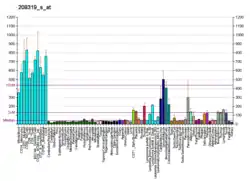RBM3
Putative RNA-binding protein 3 is a protein that in humans is encoded by the RBM3 gene.[4][5]
Function
This gene is a member of the glycine-rich RNA-binding protein family and encodes a protein with one RNA recognition motif (RRM) domain. Expression of this gene is induced by cold shock and low oxygen tension. A pseudogene exists on chromosome 1. Alternate transcriptional splice variants, encoding different isoforms, have been characterized.[5]
RBM3 is cold-induced RNA binding protein and is involved in mRNA biogenesis exerts anti-apoptotic effects.[6] According to antibody-based profiling and transcriptomics analysis, RBM3 protein is present in all analysed human tissues[7] and based on confocal microscopy mainly localised to the nucleoplasm.[8]
Clinical significance
RBM3 is a proto-oncogene that is associated with tumor progression and metastasis and is a potential cancer biomarker.[6] Based on patient survival data, high levels of RBM3 protein in tumor cells is a favourable prognostic biomarker in colorectal cancer.[9]
References
- GRCh38: Ensembl release 89: ENSG00000102317 - Ensembl, May 2017
- "Human PubMed Reference:". National Center for Biotechnology Information, U.S. National Library of Medicine.
- "Mouse PubMed Reference:". National Center for Biotechnology Information, U.S. National Library of Medicine.
- Derry JM, Kerns JA, Francke U (December 1995). "RBM3, a novel human gene in Xp11.23 with a putative RNA-binding domain". Human Molecular Genetics. 4 (12): 2307–11. doi:10.1093/hmg/4.12.2307. PMID 8634703.
- "Entrez Gene: RBM3 RNA binding motif (RNP1, RRM) protein 3".
- Zhou RB, Lu XL, Zhang CY, Yin DC (March 2017). "RNA binding motif protein 3: a potential biomarker in cancer and therapeutic target in neuroprotection". Oncotarget. 8 (13): 22235–22250. doi:10.18632/oncotarget.14755. PMC 5400660. PMID 28118608.
- "Tissue expression of RBM3 - Summary". The Human Protein Atlas.
- "Cell atlas - RBM3". The Human Protein Atlas.
- "Expression of RBM3 in cancer - Summary". The Human Protein Atlas.
Further reading
- Danno S, Nishiyama H, Higashitsuji H, Yokoi H, Xue JH, Itoh K, Matsuda T, Fujita J (July 1997). "Increased transcript level of RBM3, a member of the glycine-rich RNA-binding protein family, in human cells in response to cold stress". Biochemical and Biophysical Research Communications. 236 (3): 804–7. doi:10.1006/bbrc.1997.7059. PMID 9245737.
- Chappell SA, Mauro VP (September 2003). "The internal ribosome entry site (IRES) contained within the RNA-binding motif protein 3 (Rbm3) mRNA is composed of functionally distinct elements". The Journal of Biological Chemistry. 278 (36): 33793–800. doi:10.1074/jbc.M303495200. PMID 12824175.
- Wellmann S, Bührer C, Moderegger E, Zelmer A, Kirschner R, Koehne P, Fujita J, Seeger K (April 2004). "Oxygen-regulated expression of the RNA-binding proteins RBM3 and CIRP by a HIF-1-independent mechanism". Journal of Cell Science. 117 (Pt 9): 1785–94. doi:10.1242/jcs.01026. PMID 15075239.
- Brill LM, Salomon AR, Ficarro SB, Mukherji M, Stettler-Gill M, Peters EC (May 2004). "Robust phosphoproteomic profiling of tyrosine phosphorylation sites from human T cells using immobilized metal affinity chromatography and tandem mass spectrometry". Analytical Chemistry. 76 (10): 2763–72. doi:10.1021/ac035352d. PMID 15144186.
- Dellis S, Strickland KC, McCrary WJ, Patel A, Stocum E, Wright CF (November 2004). "Protein interactions among the vaccinia virus late transcription factors". Virology. 329 (2): 328–36. doi:10.1016/j.virol.2004.08.017. hdl:10161/15063. PMID 15518812.
- Andersen JS, Lam YW, Leung AK, Ong SE, Lyon CE, Lamond AI, Mann M (January 2005). "Nucleolar proteome dynamics". Nature. 433 (7021): 77–83. doi:10.1038/nature03207. PMID 15635413.
- Ong SE, Mittler G, Mann M (November 2004). "Identifying and quantifying in vivo methylation sites by heavy methyl SILAC". Nature Methods. 1 (2): 119–26. doi:10.1038/nmeth715. PMID 15782174.
- Martínez-Arribas F, Agudo D, Pollán M, Gómez-Esquer F, Díaz-Gil G, Lucas R, Schneider J (April 2006). "Positive correlation between the expression of X-chromosome RBM genes (RBMX, RBM3, RBM10) and the proapoptotic Bax gene in human breast cancer". Journal of Cellular Biochemistry. 97 (6): 1275–82. doi:10.1002/jcb.20725. PMID 16552754.


